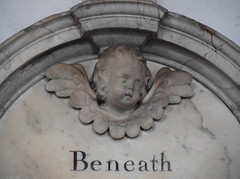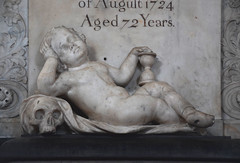| |
|
St George
Colegate, Norwich
 |
|
This
area of the city centre, Coslany or 'Norwich over
the water', is home to about half a dozen
medieval parish churches, of which St George is
the sole working survivor. This was one of the
most intensely industrialised areas of Norwich in
the Nineteenth Century, and the blackened flint
of the walls still bears testimony to this. Now,
the inner ring road is not far off, and the area
is redeveloped with wine bars, law firms and loft
conversions. Norwich has consciously tried to
develop residential areas in the heart of the
city, with considerable success, and this has
contributed to the feeling of St George being a
living church in the heart of a community. Although
not as big as the likes of St Andrew and St Peter
Mancroft, this is a large, determinedly
Perpendicular church from the years when the
Fifteenth Century was becoming the Sixteenth. The
tall, stone-faced clerestory marches determinedly
eastwards, its windows as big as those in the
aisles, but without the delicate 'wall of glass'
effect typical of the time. This clerestory was
meant to express grandeur and permanence as much
as to admit rational light.
|
Easily
missed, but notable and worth seeking out, is the grand
west doorway beneath the tower, obviously designed for
processions. In the spandrels, you can see a paired scene
from the story of the church's patron Saint. On the left,
the princess and her family watch from the tower of their
castle as St George neatly dispatches the dragon on the
other side. Above, the eroded shields would once have
borne sacred monograms, instruments of the passion, or
even the crests of local worthy families.
A
surprise, then, to go inside and find that the vast,
clear windows fill with light what is still largely
furnished as an early Eighteenth Century urban interior,
as if we were in the City of London. In truth, of course,
just as central London was prosperous at this time, so
was central Norwich, and what you see here must have been
what many other churches in the city were like. Quite
literally in fact, because St George is now home to many
Eighteenth Century furnishings stripped out of other
churches that fell to redundancy. Anyone familiar with
the City of London's St Margaret Lothbury will recognise
the same result here of a treasure house of the survivals
of other churches. St George was almost derelict after
the war, thanks to bomb damage and neglect, and so their
fates really saved its life.
Because of
the size of the windows and the lack of coloured glass,
the heavy dark wood is not hard to bear, the west gallery
is not oppressive. The tiling of the floor is harmonious,
the sheer white of the Fourteenth Century font a striking
central feature. The font appears as if it has been
cobbled together. The bowl and shaft may be from
different fonts, and the connection between is probably
Victorian. It came from St Saviour, just to the north.
The original Purbeck marble font went to St Peter Hungate
when it was a museum of church furnishings, and is
probably in storage somewhere now.
The white
walls and opulent furnishings make St George a pleasant
place to wander and explore the city's best collection of
wall memorials of the Eighteenth and early Nineteenth
Centuries. These include one to Edmund Manning,
Gentleman, who, in 1838, desirous of imparting such
useful instruction to the poor when young, as may enable
them to respectably maintain themselves in their riper
years, bequeathed the interest and dividends of Four
Thousand Pounds in three percent consols to be held in
trust forever by the trustees of the charity schools in
this city, for annually binding as apprentices to some
manufacturing trades twelve poor children to be selected
from six parishes specified in his will, of which number
this parish is one.
This is
interesting for several reasons. Manning's bequest was
immediately after the 1834 Poor Law Act which had turned
workhouses from houses of industry into places of
degradation, hardship and shame. Manning obviously saw a
good reason for helping the poor stay out of them.
Consols, or Consolidated Stock, were a way of financing
government borrowing in return for interest, and 3%
consols were created by Sir Henry Pelham's Whig
administration in 1757 to consolidate existing government
borrowing. They continued to pay out 3% until the 1880s,
and existed in a slightly different form until as late as
2015, when the Coalition Government of David Cameron paid
them all back.
| At
the east end of the south aisle is the 1821
memorial to John Crome who, as the inscription
reminds us, was one of England's greatest
landscape painters. The memorial bears a
relief portrait of Crome, a wreath above his
head, his palette and brushes at rest below. As you
wander, you will eventually find the north
chancel chapel, now home to a large terracotta
tomb chest and a triple figure brass. The tomb is
to Robert Jannys, a Mayor of Norwich who died in
1530. Tombs of this type are interesting, because
they were produced right on the eve of the
Reformation, and give us an inkling of what the
English Renaissance might have been like. Though
smaller, this recalls the Bedingfield tombs at
Oxborough. Pevsner wondered if it might have been
the same craftsman. The brass depicts a Mayor
from half a century earlier, the aptly named
William Norwiche and his wife, with the figure of
their son between them.
|
|
 |
Simon Knott, January 2018
|
|
|
